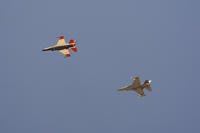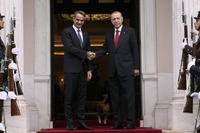
Given last week's downing of a Turkish RF-4 Phantom, that was likely on a recconaissance mission, by the Syrian military, we thought it would be an appropriate time to look at Syria's air defenses.
We frequently hear White House and Pentagon officials citing Syria's advanced air defenses as a reason for thinking twice about starting an air campaign against the government of Bashar al Assad. Ask an American intel officer and I bet he'll tell you that he's spent plenty of time looking at how the U.S. would penetrate Syria's integrated air defenses, which are some of the thickest and most advanced in the region, some claim they are tougher to penetrate than Iran's.
Remember a few years ago when Israeli war planes managed to take out a suspected nuclear facility inside Syria? Well, that prompted Damascus to buy some advanced weaponry from Russia -- a move that may have allowed it to give its older 1970s-vintage Soviet-made air defense gear to Hezbollah in Lebanon. (If you want to read about how effective those systems were, just read this.)
So, what has the Syrian air defense corps been upgrading its old SA-2s and SA-6s with? Well, rumors about that the RF-4 was shot down by a brand new Russian-made SA-22 system. The SA-22 is a mobile antiaircraft system the equipped with its own target acquisition and tracking radars and it carries 12 medium range 57E6 radio-guided surface-to-air missiles and two 30 mm autocannon. Yeah, it's a nasty little system designed to protect ground troops, cities and even more advanced, high-altitude surface to air missile systems.
Speaking of high-altitude Russian-built SAM systems, dubbed triple digit SAMS, that keep American planners awake at night, Syria's probably got them.
Specifically, Damascus reportedly has the S-300 air defense system that has long been considered one of the world's most advance SAM systems.
Still, as this Seattle Times article points out, just because Syria has some fancy -- and threatening -- Russian hardware doesn't mean that it's military is fully adept at operating it, nor does it mean that the United States hasn't figured out how it will deal with such SAM threats.
"We can deal with the Syrian integrated air defenses," said retired Lt. Gen. David Deptula, who oversaw Air Force intelligence efforts in the Pentagon. "It is much, much more challenging than Libya. They have some of the most recent surface-to-air missiles out there. But before we address the how, we need to address the why."
The article goes on to say:
Even a relatively sophisticated air-defense system has potential weaknesses. Although Syria's looks good on paper, it's not clear the Syrians have the trained personnel to operate it effectively, analysts said.U.S. officials said they are also unsure whether the Syrians can maintain and repair the system.
The U.S. and NATO forces would also employ jammers and other sophisticated technology to disrupt Syria's radar and communications systems not in use by the Turkish aircraft.
Remember, Russia may have stopped deliveries of S-300 systems and it may have pulled out its technicians advising Syrians on how to use the systems.








